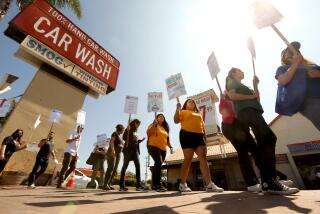Little Compensation in Capitol Fight
- Share via
The legislative battle over California’s $10-billion a year workers’ compensation system ended last week with only a small loss for newly employed workers, but no workers made any gains.
John Henning, head of the California Labor Federation, wasn’t exactly happy, calling it only “a great defensive victory.”
The latest fight over the program began when Gov. Pete Wilson made the mistake of agreeing to the changes in workers’ compensation law in exchange for a tax hike on the wealthy.
The governor agreed to hold the entire budget hostage until the Legislature agreed to “reform” the workers’ compensation system to reduce employers’ costs.
Wilson finally backed away from the most onerous of those “reforms” designed to help employers.
Then, as part of the compromise, the more pro-union Democrats in the Legislature backed away from a sensible proposal that would have repealed the “minimum insurance rate rule.” That is a decades-old, anti-free enterprise gimmick that blocks competition and pretty much guarantees insurance companies hefty profits on workers’ compensation policies.
All that maneuvering allowed the governor and the Democrats to finalize what some euphemistically called a “soak the rich” tax plan that was to be indirectly eased by making massive cuts in employer-paid workers’ compensation benefits.
However, the tax plan won’t really soak the rich. It will hardly dampen them.
It just temporarily restores the 11% top tax rate then-Gov. George Deukmejian reduced in 1987 to help Californians with lots of money. That “help the rich” tax plan was in line with a similar scheme adopted nationwide under President Reagan.
The latest California tax plan aimed at the wealthy will only mean, for example, that a couple grossing $300,000 a year will have to fork over $1,200 a year more in taxes--if they don’t figure out some new exemptions--according to figures from state Controller Gray Davis.
There goes a couple of fancy dinner parties each year, but they will have enough left for many others.
Oh, and the governor did manage after the legislative battle to nick workers with one last swipe. He cut $1 million out of the budget for the administration of workers’ compensation, which will mean more delays in processing their claims. The only positive part of the finale is a law that should slow fraudulent conduct by sleazy entrepreneurs and some doctors and lawyers whose business is to encourage and help companies or workers cheat the system.
That section, pushed by two Democrats, Sen. Robert Presley and Assemblyman Burt Margolin, makes it a felony for anyone to give false information either for a worker’s claim for benefits or, equally important, for an employer trying to avoid paying a legitimate claim.
Steadily increasing costs have spurred employer demands that legislators in all states reduce benefits paid to those who are injured or made ill on the job.
Some states have made significant benefit reductions and made it more difficult for workers to get them. Other states, though, treat those hurt on their jobs more generously than California does.
With some imaginative thinking, this state could once again become a bellwether in dealing with the medical and economic problems faced by the hundreds of thousands of workers whose jobs damage or even kill them.
The state Legislature should follow through on preliminary studies made about the possibility of what is called a “one-window” system that would combine the various ways we now provide assistance to those who are hurt either on or off the job.
Employers and workers spend billions of dollars on lawyers and doctors just deciding how much, if any, of a worker’s injury or illness is due to the job.
But what is the difference whether, for instance, you wrench your back out of shape lifting a sack of potatoes in a grocery warehouse or do it mowing your lawn? You ought to be able to get help for both your injured back and for an income if you aren’t able to work because of it.
An intriguing “New Vision” proposal for possible alternatives to our present chaotic workers’ compensation system was made for the California state Senate last year, but generally ignored.
In sum, the proposal prepared by, among others, Senate consultant Casey Young, suggests combining programs, such as workers’ compensation and disability insurance, as a way of saving money. And California has a head start on that possibility.
This is one of just six states with a worker-financed disability insurance system that provides benefits to, for instance, the person who suffered that back injury while mowing the lawn and is unable to work.
We also have the workers’ compensation system for the those with that job-caused back problem. Also, most of us have at least limited health insurance, plus some protection under Social Security for serious, long-term disabilities.
The idea is that vast sums of money spent in litigation and administration could be saved by simplifying what Casey calls “this archaic system.” It won’t be easy to combine the disparate programs, but some of the groundwork has already been done by him and others.
Ultimately, of course, the best answer is national health insurance to meet everyone’s medical needs. Meanwhile, however, the Legislature should start on a major overhaul of workers’ compensation instead of tinkering with our outdated system that was designed nearly a century ago.
More to Read
Get the L.A. Times Politics newsletter
Deeply reported insights into legislation, politics and policy from Sacramento, Washington and beyond. In your inbox twice per week.
You may occasionally receive promotional content from the Los Angeles Times.










